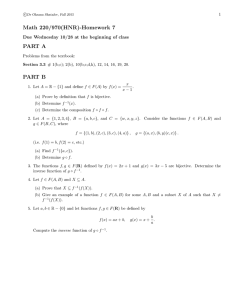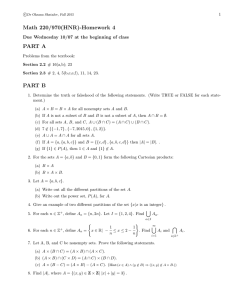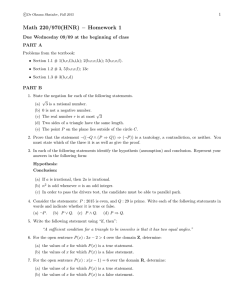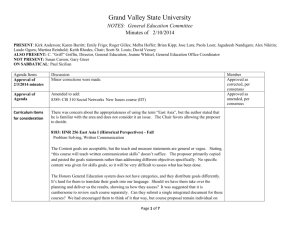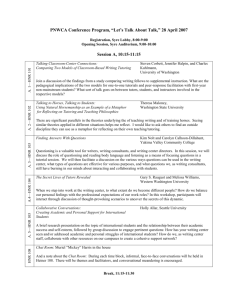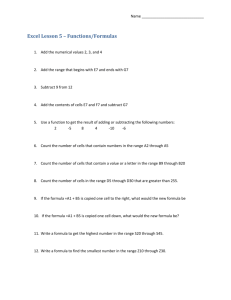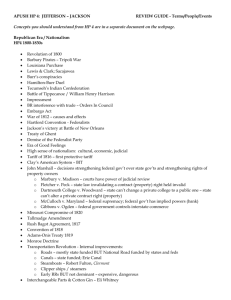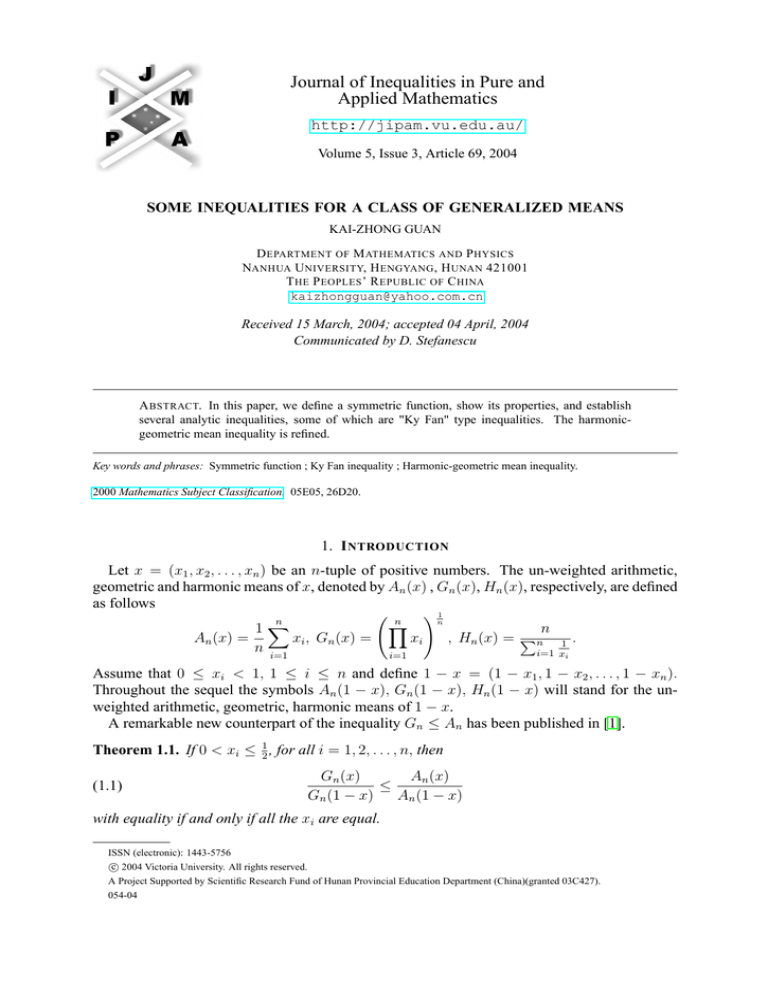
Journal of Inequalities in Pure and
Applied Mathematics
http://jipam.vu.edu.au/
Volume 5, Issue 3, Article 69, 2004
SOME INEQUALITIES FOR A CLASS OF GENERALIZED MEANS
KAI-ZHONG GUAN
D EPARTMENT OF M ATHEMATICS AND P HYSICS
NANHUA U NIVERSITY, H ENGYANG , H UNAN 421001
T HE P EOPLES ’ R EPUBLIC OF C HINA
kaizhongguan@yahoo.com.cn
Received 15 March, 2004; accepted 04 April, 2004
Communicated by D. Stefanescu
A BSTRACT. In this paper, we define a symmetric function, show its properties, and establish
several analytic inequalities, some of which are "Ky Fan" type inequalities. The harmonicgeometric mean inequality is refined.
Key words and phrases: Symmetric function ; Ky Fan inequality ; Harmonic-geometric mean inequality.
2000 Mathematics Subject Classification. 05E05, 26D20.
1. I NTRODUCTION
Let x = (x1 , x2 , . . . , xn ) be an n-tuple of positive numbers. The un-weighted arithmetic,
geometric and harmonic means of x, denoted by An (x) , Gn (x), Hn (x), respectively, are defined
as follows
! n1
n
n
Y
1X
n
An (x) =
xi , Gn (x) =
xi
, Hn (x) = Pn 1 .
n i=1
i=1 xi
i=1
Assume that 0 ≤ xi < 1, 1 ≤ i ≤ n and define 1 − x = (1 − x1 , 1 − x2 , . . . , 1 − xn ).
Throughout the sequel the symbols An (1 − x), Gn (1 − x), Hn (1 − x) will stand for the unweighted arithmetic, geometric, harmonic means of 1 − x.
A remarkable new counterpart of the inequality Gn ≤ An has been published in [1].
Theorem 1.1. If 0 < xi ≤ 12 , for all i = 1, 2, . . . , n, then
(1.1)
Gn (x)
An (x)
≤
Gn (1 − x)
An (1 − x)
with equality if and only if all the xi are equal.
ISSN (electronic): 1443-5756
c 2004 Victoria University. All rights reserved.
A Project Supported by Scientific Research Fund of Hunan Provincial Education Department (China)(granted 03C427).
054-04
2
K AI -Z HONG G UAN
This result, commonly referred to as the Ky Fan inequality, has stimulated the interest of
many researchers. New proofs, improvements and generalizations of the inequality (1.1) have
been found. For more details, interested readers can see [2], [3] and [4].
W.-L. Wang and P.-F. Wang [5] have established a counterpart of the classical inequality
Hn ≤ Gn ≤ An . Their result reads as follows.
Theorem 1.2. If 0 < xi ≤ 12 , for all i = 1, 2, . . . , n, then
(1.2)
Hn (x)
Gn (x)
An (x)
≤
≤
.
Hn (1 − x)
Gn (1 − x)
An (1 − x)
All kinds of means about numbers and their inequalities have stimulated the interest of many
researchers. Here we define a new mean, that is:
Definition 1.1. Let x ∈ Rn+ = {x|x = (x1 , x2 , . . . , xn )|xi > 0, i = 1, 2, . . . , n}, we define the
symmetric function as follows
"
!# n1
(r)
Y
r
Pr
Hnr (x) = Hnr (x1 , x2 , . . . , xn ) =
.
−1
x
i
i=1
j
1≤i1 <···ir ≤n
n!
Clearly Hnn (x) = Hn (x) , Hn1 (x) = Gn (x), where nr = r!(n−r)!
.
The Schur-convex function was introduced by I. Schur in 1923 [7]. Its definition is as follows:
Definition 1.2. f : I n → R(n > 1) is called Schur-convex if x ≺ y, then
(1.3)
f (x) ≤ f (y)
for all x, y ∈ I n = I ×I ×· · ·×I (n copies). It is called strictly Schur-convex if the inequality is
strict; f is called Schur-concave (resp. strictly Schur-concave) if the inequality (1.3) is reversed.
For more details, interested readers can see [6], [7] and [8].
The paper is organized as follows. A refinement of harmonic-geometric mean inequality
is obtained in Section 3. In Section 4, we investigate the Schur-convexity of the symmetric
function. Several “Ky Fan” type inequalities are obtained in Section 5.
2. L EMMAS
In this section, we give the following lemmas for the proofs of our main results.
Lemma 2.1. ([5]) If 0 < xi ≤ 21 , for all i = 1, 2, . . . , n, then
" Qn 1 # n1
Pn
1
Hn (x)
Gn (x)
i=1
i=
i
i
Pn 1−x
or
≤
.
(2.1)
≤ Qn 1−x
1
1
Hn (1 − x)
Gn (1 − x)
i=1 xi
i= xi
Pn+1
Lemma 2.2. If 0 < xi ≤ 21 , for all i = 1, 2, . . . , n + 1, and Sn+1 =
i=1
Pn+1 1
,
then
i=1 1−xi
1
n Q
n+1
Pn+1 n+1
1
1
S
−
S
−
n+1
n+1
i=1
i=1
1−xi
1−xi
≤ Q
(2.2)
.
Pn+1 n+1
1
1
S
−
S
−
n+1
n+1
i=1
i=1
xi
xi
J. Inequal. Pure and Appl. Math., 5(3) Art. 69, 2004
1
,
xi
S n+1 =
http://jipam.vu.edu.au/
S OME I NEQUALITIES FOR A C LASS OF G ENERALIZED M EANS
3
Proof. Inequality (2.2) is equivalent to the following
Qn+1 1
S
−
n+1
i=1
1−xi
S n+1
1
n ln
≤
ln Qn+1
1
Sn+1
n+1
(S
−
)
n+1
i=1
xi
Since 0 < xi ≤ 21 , and 1 − xi ≥ xi , it follows that
1
1−xj
Sn+1 − x1j
S n+1 −
=
≥
1
1−x1
+ ··· +
1
x1
1
1−x1
+ ···
1
1−xj−1
1
+ xj−1
+
+
1
+ · · · + 1−x1n+1
1−xj+1
1
1
+ · · · + xn+1
xj+1
· · · 1−x1j−1 1−x1j+1 · · · 1−x1n+1
1
x1
1
1
1
· · · xj−1
· · · xn+1
xj+1
.
By the above inequality and Lemma 2.1, we have
n+1
n+1
1
Y S n+1 − 1−x
Y 1 1 n
1
1
i
ln
≥
ln
n + 1 i=1 Sn+1 − x1i
n + 1 i=1
1 − xi
xi
n+1
Y 1 1 n+1
= n ln
1 − xi
xi
i=1
≥ n ln
1
1−x1
1
x1
+ ··· +
+ ··· +
1
1−xn+1
1
xn+1
,
or
Qn+1 n ln
1
1−xi
i=1 S n+1 −
S n+1
1
≤
ln Q
n+1
Sn+1
n+1
S
−
i=1
n+1
1
xi
.
Lemma 2.3. [6, p. 259]. Let f (x) = f (x1 , x2 , . . . , xn ) be symmetric and have continuous
partial derivatives on I n , where I is an open interval. Then f : I n → R is Schur-convex if and
only if
∂f
∂f
(2.3)
(xi − xj )
−
≥0
∂xi ∂xj
on I n . It is strictly Schur-convex if (2.3) is a strict inequality for xi 6= xj , 1 ≤ i, j ≤ n.
Since f (x) is symmetric, Schur’s condition can be reduced as [7, p. 57]
∂f
∂f
(2.4)
(x1 − x2 )
−
≥ 0,
∂x1 ∂x2
and f is strictly Schur-convex if (2.4) is a strict inequality for x1 6= x2 . The Schur condition
that guarantees a symmetric function being Schur-concave is the same as (2.3) or (2.4) except
the direction of the inequality.
In Schur’s condition, the domain of f (x) does not have to be a Cartesian product I n . Lemma
2.3 remains true if we replace I n by a set A ⊆ Rn with the following properties ([7, p. 57]):
(i) A is convex and has a nonempty interior;
(ii) A is symmetric in the sense that x ∈ A implies P x ∈ A for any n × n permutation
matrix P .
J. Inequal. Pure and Appl. Math., 5(3) Art. 69, 2004
http://jipam.vu.edu.au/
4
K AI -Z HONG G UAN
3. R EFINEMENT OF THE H ARMONIC -G EOMETRIC M EAN I NEQUALITY
The goal of this section is to obtain the basic inequality of Hnr (x), and give a refinement of
the Harmonic-Geometric mean inequality.
Theorem 3.1. Let x ∈ Rn+ = {x|x = (x1 , x2 , . . . , xn )|xi > 0, i = 1, 2, . . . , n}, then
Hnr+1 (x) ≤ Hnr (x),
(3.1)
r = 1, 2, . . . , n − 1.
Proof. By the arithmetic-geometric mean inequality and the monotonicity of the function y =
ln x, we have
X
r+1
n
ln Pr+1 −1
ln Hnr+1 (x) =
r+1
j=1 xij
1≤i1 <···<ir+1 ≤n
#
"
X
(r + 1)r
=
ln
Pr+1 −1 Pr+1 −1
(r + 1) k=1 xik − j=1 xij
1≤i1 <···<ir+1 ≤n
X
r
i.
=
ln hP P
r+1
r+1 −1
−1
(r + 1)
1≤i1 <···<ir+1 ≤n
j=1
k=1 xik − xij
X
r
ln ≤
1
r+1
Qr+1 Pr+1 −1
−1
1≤i1 <···<ir+1 ≤n
j=1
k=1 xik − xij
1
"r+1
# r+1
X
Y
r
=
ln
Pr+1 −1
−1
k=1 xik − xij
j=1
1≤i1 <···<ir+1 ≤n
" r+1
#
X
X
1
r
=
ln Pr+1 −1
−1
r + 1 1≤i <···<i ≤n j=1
k=1 xik − xij
1
r+1
=
i1 ,...,ir 6=j
n
X
r
1 X
ln Pr
−1 .
r + 1 j=1 1≤i <···<i ≤n
k=1 xik
r
1
Let
i1 ,...,ir 6=j
X
Sj =
ln Pr
1≤i1 <···<ir ≤n
We can easily get
n
X
Sj = (n − r)
k=1
n
r+1
ln Hnr+1 (x)
x−1
ik
ln Pr
1≤i1 <···<ir ≤n
j=1
Thus
X
r
,
r
−1
k=1 xik
j = 1, 2, . . . , n.
= (n − r)
n − r n
≤
ln Hnr (x) =
r+1 r
n
r
n
r+1
ln Hnr (x).
ln Hnr (x),
or
Hnr+1 (x) ≤ Hnr (x),
r = 1, 2, . . . , n − 1.
Corollary 3.2. Let x ∈ Rn+ = {x|x = (x1 , x2 , . . . , xn )|xi > 0, i = 1, 2, . . . , n}, then
(3.2)
Hn (x) ≤ Hnn−1 (x) ≤ · · · ≤ Hn2 (x) ≤ Hn1 (x) = Gn (x).
J. Inequal. Pure and Appl. Math., 5(3) Art. 69, 2004
http://jipam.vu.edu.au/
S OME I NEQUALITIES FOR A C LASS OF G ENERALIZED M EANS
5
Remark 3.3. The corollary refines the harmonic-geometric mean inequality.
4. S CHUR - CONVEXITY OF THE F UNCTION Hnr (x)
In this section, we investigate the Schur-convexity of the function Hnr (x), and establish several analytic inequalities by use of the theory of majorization.
Theorem 4.1. Let Rn+ = {x|x = (x1 , x2 , . . . , xn )|xi > 0, i = 1, 2, . . . , n}, then the function
Hnr (x) is Schur-concave in Rn+ .
Proof. It is clear that Hnr (x) is symmetric and has continuous partial derivatives on Rn+ . By
Lemma 2.3, we only need to prove
(x1 − x2 )
∂Hnr (x) ∂Hnr (x)
−
∂x1
∂x2
≤ 0.
As matter of fact, we can easily derive
ln Hnr (x) =
1
X
ln Pr
n
r
r
−1
j=1 xij
2≤i1 <···<ir ≤n
X
+
ln
2≤i1 <···<ir−1 ≤n
x−1
1
r
Pr−1
+
j=1
x−1
ij
.
Differentiating ln Hnr (x) with respect to x1 , we have
∂Hnr (x)
∂x1
=
Hnr (x)
n
r
=
Hnr (x)
n
r
X
x−1
2≤i1 <···<ir−1 ≤n 1
+
1
Pr−1
−1
j=1 xij
·
X
1
x21
3≤i <···<i
1
x−1
1
r−1 ≤n
+
· 1
x21
1
Pr−1
−1
j=1 xij
1
X
+
3≤i1 <···<ir−2 ≤n
x−1
1
+
x−1
2
+
Pr−2
−1
j=1 xij
.
Similar to the above, we can also obtain
∂Hnr (x)
∂x2
=
Hnr (x)
n
r
=
Hnr (x)
n
r
X
x−1
2≤i1 <···<ir−1 ≤n 2
+
1
Pr−1
−1
j=1 xij
·
X
1
x22
3≤i <···<i
1
x−1
2
r−1 ≤n
+
· 1
x22
1
Pr−1
−1
j=1 xij
+
3≤i1 <···<ir−2 ≤n
J. Inequal. Pure and Appl. Math., 5(3) Art. 69, 2004
1
X
x−1
1
+
x−1
2
+
Pr−2
−1
j=1 xij
.
http://jipam.vu.edu.au/
6
K AI -Z HONG G UAN
Thus
∂Hnr (x) ∂Hnr (x)
(x1 − x2 )
−
∂x1
∂x2
X
H r (x)
= (x1 − x2 ) nn
x−1
2≤i1 <···<ir−1 ≤n 1
r
1
Pr−1
−1
j=1 xij
+
· 1
x21
X
−
x−1
2≤i1 <···<ir−1 ≤n 2
+
1
Pr−1
−1
j=1 xij
1
X
+
· 1
x22
3≤i1 <···<ir−2 ≤n
−1
x−1
1 + x2 +
Pr−2
x−1
ij
j=1
1
1
− 2
2
x1 x2
= −(x1 − x2 )2
X
(x1 + x2 )
x21 x22 3≤i <···<i
1
x−1
1
r−2 ≤n
+
x−1
2
1
P
−1
+ r−2
j=1 xij
P
−1
1 + (x1 + x2 ) r−1
x
i
j=1 jP
+
P
r−1
r−1 −1
−1
−1
−1
2 2
x2 + j=1 xij
2≤i1 <···<ir−1 ≤n x1 x2 x1 +
j=1 xij
X
≤ 0.
Pn
Corollary 4.2. Let xi > 0, i = 1, 2, . . . , n, n ≥ 2 ,and i=1 xi = s, c > 0, then
n1
Hnr (c + x) nc
(r)
≥
+
1
,
r = 1, 2, . . . , n,
(4.1)
r
Hn (x)
s
where c + x = (c + x1 , c + x2 , . . . , c + xn ).
Proof. By [9], we have
c+x
=
nc + s
c + x1
c + xn
,...,
nc + s
nc + s
≺
x
1
s
,...,
xn x
= .
s
s
Using Theorem 4.1, we obtain
Hnr
c+x
nc + s
≥ Hnr
x
s
.
Or
n1
Hnr (c + x) nc
( )
≥
+1 r .
r
Hn (x)
s
P
Corollary 4.3. Let xi > 0, i = 1, 2, . . . , n, n ≥ 2, and ni=1 xi = s, c ≥ s, then
n1
Hnr (c − x) nc
( )
(4.2)
≥
− 1 r , r = 1, 2, . . . , n,
r
Hn (x)
s
where c − x = (c − x1 , c − x2 , . . . , c − xn ).
J. Inequal. Pure and Appl. Math., 5(3) Art. 69, 2004
http://jipam.vu.edu.au/
S OME I NEQUALITIES FOR A C LASS OF G ENERALIZED M EANS
7
Proof. By [9], we have
c−x
=
nc − s
c − x1
c − xn
,...,
nc − s
nc − s
x
≺
1
s
,...,
xn x
= .
s
s
Using Theorem 4.1, we obtain
Hnr
c−x
nc − s
≥
Hnr
x
s
,
or
n1
Hnr (c − x) nc
(r)
≥
−
1
.
Hnr (x)
s
Remark 4.4. Let c = s = 1, we can obtain
1
Hnr (1 − x)
(n
r),
≥
(n
−
1)
Hnr (x)
r = 1, 2, . . . , n.
In particular,
√
Gn (1 − x)
≥ n n − 1.
Gn (x)
Hn (1 − x)
≥ (n − 1),
Hn (x)
5. S OME “K Y FAN ” T YPE I NEQUALITIES
In this section, some “Ky Fan” type inequalities are established, the Ky Fan inequality is
generalized.
Theorem 5.1. Assume that 0 < xi ≤ 12 , i = 1, 2, . . . , n, then
r1
Hnr+1 (x)
Hnr (x)
(5.1)
≤
,
r = 1, 2, . . . , n − 1.
Hnr+1 (1 − x)
Hnr (1 − x)
Proof. Set
ϕr =
Hnr (x)
Hnr (1 − x)
=
Pr
Y
1≤i1 <···<ir ≤n
1
j=1 1−xij
Pr
1
j=1 xij
1
(n
r)
.
By Lemma 2.2 and the monotonicity of the function y = ln x , we have
Pr+1 1
X
j=1 1−xi
n
ln φr+1 =
ln Pr+1 1 j
r+1
j=1 xij
1≤i1 <···<ir+1 ≤n
Pr+1 Pr+1 1
1
X
j=1
k=1 1−xik − 1−xij
=
ln P P
r+1
r+1 1
1
−
1≤i1 <···<ir+1 ≤n
j=1
k=1 xik
xij
1
r(r+1)
Pr+1 1
1
r+1
−
X
Y
k=1 1−xik
1−xij
≤
ln
Pr+1 1
1
−
k=1 xik
xij
j=1
1≤i1 <···<ir+1 ≤n
P
r
1
i1 ,...,ir 6=j
n
X
X
k=1 1−xik
1
=
ln Pr
1 .
r(r + 1) j=1 1≤i <···<i ≤n
k=1 xi
1
J. Inequal. Pure and Appl. Math., 5(3) Art. 69, 2004
r
k
http://jipam.vu.edu.au/
8
K AI -Z HONG G UAN
Similar to Theorem 3.1, we can derive
n
n
1
1
n
ln φr+1 ≤
(n − r)
ln φr =
ln φr .
r+1
r(r + 1)
r
r r+1
Thus
1
(φr ) r ≥ φr+1 ,
or
r1
Hnr+1 (x)
Hnr (x)
≤
,
Hnr+1 (1 − x)
Hnr (1 − x)
r = 1, 2, . . . , n − 1.
Remark 5.2. By Theorem 5.1, we can obtain
(5.2)
Hn1 (x)
Gn (x)
An (x)
Hn2 (x)
≤
=
≤
.
2
1
Hn (1 − x)
Hn (1 − x)
Gn (1 − x)
An (1 − x)
This is a generalization of the “Ky Fan” inequality.
By Lemma 2.1 and the proof of Theorem 3.1, we have the following
Theorem 5.3. If 0 < xi ≤ 12 , i = 1, 2, . . . , n, then
Qn
(x )
Hn (x)
Gn (x)
An (x)
Qn i=1 i
≤
≤
.
(5.3)
≤
Hn (1 − x)
Gn (1 − x)
An (1 − x)
i=1 (1 − xi )
The inequality (5.3) generalizes the inequality (1.2).
Theorem 5.4. If 0 < xi ≤ 21 , i = 1, 2, . . . , n, then
(5.4)
Hnr (x)
Hn1 (x)
Gn (x)
An (x)
≤
=
≤
,
r
1
Hn (1 − x)
Hn (1 − x)
Gn (1 − x)
An (1 − x)
r = 2, . . . , n.
Proof. Set
ϕr =
Hnr (x)
Hnr (1 − x)
Pr
Y
=
1≤i1 <···<ir ≤n
1
j=1 1−xij
Pr
1
j=1 xij
1
(n
r)
.
By Lemma 2.1 and the monotonicity of the function y = ln x , we have
Pr
1
n
X
j=1 1−xij
ln φr =
ln Pr
1
r
j=1 xij
1≤i1 <···<ir+1 ≤n
r1
Qr
1
X
j=1 1−xij
≤
ln Qr
1
j=1 xij
1≤i1 <···<ir+1 ≤n
X
1
=
r 1≤i <···<i
1
J. Inequal. Pure and Appl. Math., 5(3) Art. 69, 2004
r
X
r ≤n
j=1
ln
1
1−xij
1
xij
.
http://jipam.vu.edu.au/
S OME I NEQUALITIES FOR A C LASS OF G ENERALIZED M EANS
9
By knowledge of combination, we can easily find
" n 1 #( n−1
r−1 )
n
Y 1−x
1
i
ln φr ≤ ln
1
r
r
i=1 xi
#
"Y
n
1
1 n−1
1−xi
=
ln
1
r r−1
i=1 xi
n
1 n−1
ln φ1 =
ln φ1 .
=
r r−1
r
Thus
φr ≤ φ1 , r = 2, . . . , n,
or
Hnr (x)
Gn (x)
(5.5)
≤
, r = 2, . . . , n.
r
Hn (1 − x)
Gn (1 − x)
The inequality (5.5) generalizes the “Ky Fan” inequality.
R EFERENCES
[1] E.F. BECKENBACH AND R. BELLMAN, Inequalities, Springer-Verlag, New York, 1965.
[2] H. ALZER, The inequality of Ky Fan and related results, Acta. Appl. Math., 38 (1995), 305–354.
[3] J. SÁNDOR, On an inequaliy of Ky Fan, Babeş-Bolyai Univ., Fac. Math. Phys., Res. Semin., 7
(1990), 29–34.
[4] J. SÁNDOR AND T. TRIF, A new refinement of the Ky Fan inequality, Math. Inequal. Appl., 2
(1999), 529–533.
[5] W.-L. WANG AND P.-F. WANG, A class of inequalities for symmetric functions (in chinese), Acta.
Math .Sinica, 27 (1984), 485–497.
[6] A.W. ROBERTS AND D.E. VARBERG, Convex Function, Academic Press, New York, San Francisco, London, 1973.
[7] A.W. MARSHALL AND I. OLKIN, Inequalities: Theory of Majorization and Its Applications, Academic Press, 1979.
[8] D.S. MITRINOVIĆ, Analytic Inequalities, Springer-Verlag, New York, 1970.
[9] HUANNAN SHI, Refinement and generalization of a class of inequalities for symmetric functions
(in Chinese), Mathematics in Practices and Theory, 4 (1999), 81–84.
J. Inequal. Pure and Appl. Math., 5(3) Art. 69, 2004
http://jipam.vu.edu.au/


